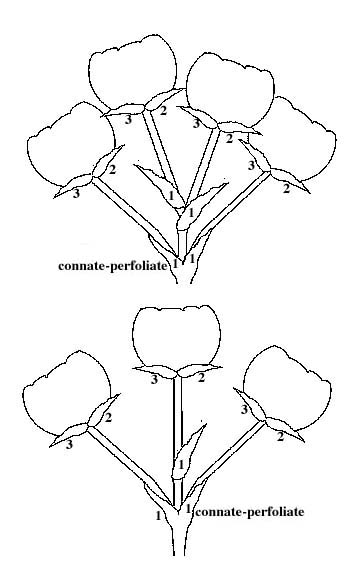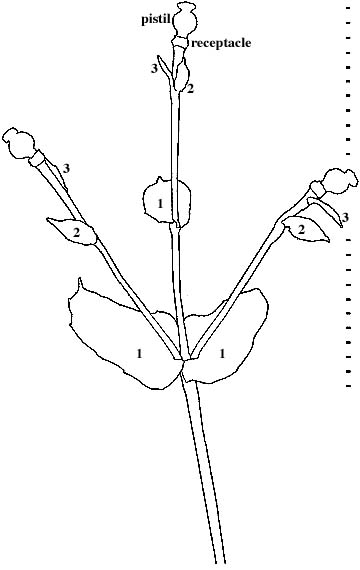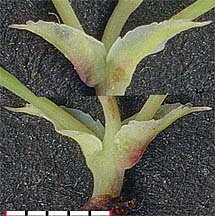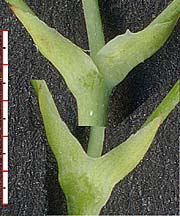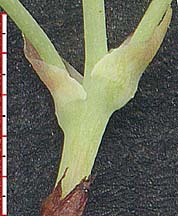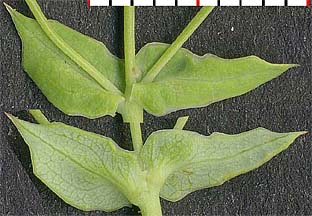Inflorescence

The Berberis Inflorescence
| B. trifoliolata | |
| B. swaseyi | B. swaseyi X B. trifoliolata |
| Click here to open page with larger images | |
Inflorescences emerge from bud scales at both long and short shoot tips - including newly formed lateral bud scales on long shoots, presumably initial stages of a new short shoot.
B. trifoliolata emerging bud scales/inflorescence on long shoot.
Click for page with greater detail.
Each shoot tip generally has (1) 2-4 (5) inflorescences in a cluster, with B. trifoliolata averaging fewer (2-3) than B. swaseyi and the hybrids.
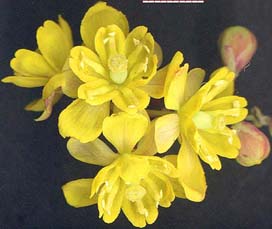 |
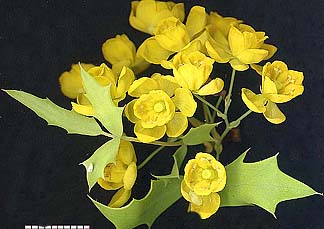 |
| B. trifoliolata | B. swaseyi X B. trifoliolata |
| Click here to open page with larger images | |
With B. swaseyi new leaves emerge together with the inflorescences, creating a light green cluster of leafs, prophylls and flowers. Leaf flush with B. trifoliolata is essentially independent of blooming, although under conditions of abundant moisture these may coincide. In 2005 as a result of very heavy winter rains B. trifoliolata primarily developed new vegetative growth, and the number of flower shoots was significantly reduced in comparison with 2004 - most bushes producing only new growth and no flowers.
Berberis Inflorescence Morphology
Our two species can generally be distinguished on the basis of their inflorescence morphology alone, with some overlap in a number of features, such as number of flowers, B. trifoliolata with mostly 3(-4) flowers, B. swaseyi with mostly 4(-5) flowers, and hybrids essentially intermediate.| no. flowers | 2 | 3 | 4 | 5 | 6 | tokens |
|---|---|---|---|---|---|---|
| B. trifoliolata | 0 | 64% | 28% | 7% | 0 | 271 |
| B. swaseyi X B. trifoliolata | 2% | 44% | 52% | 3% | 0 | 66 |
| B. swaseyi | 0 | 7% | 60% | 31% | 12% | 146 |
| Number of flowers per inflorescence. | ||||||
The inflorescences of each of our types vary from racemose to umbellate, depending to some extent on the number of flowers. The basal three flowers are often umbellate or subracemose, with additional flowers generally racemose (with rare umbelliform extension with 5-flowered B. trifoliolata). Counted as subracemose are highly compressed racemes, which tend to appear umbellate unless examined at higher magnification.
 |
 |
| B. trifoliolata Petals removed – Prophylls all attached at the receptacle. |
B. swaseyi – in bud |
| Racemes. [Note difference in scales.] | |
| Click here to open page with larger images | |
| umbel | subraceme | raceme | |
|---|---|---|---|
| B. trifoliolata | 96.5% | 0% | 3.5% |
| B. swaseyi X B. trifoliolata | 83% | 9% | 8% |
| B. swaseyi | 37.5% | 36.5% | 26% |
| Inflorescence forms of basal three flowers. | |||
In my view - which differs from earlier interpretations of the inflorescence bract morphology - each flower is subtended by a spiral of 3 prophylls (bracteoles), a continuation of the trimerous whorl structure of the flower stamens, petals and sepals. The lowest of these is at or near the base of its pedicel, the highest is often appressed to the outer sepals or attached near the receptacle, and the third between these or also at the receptacle. When two are at the receptacle, they are not opposite, but rather positioned as two components of a trimerous whorl/spiral.
